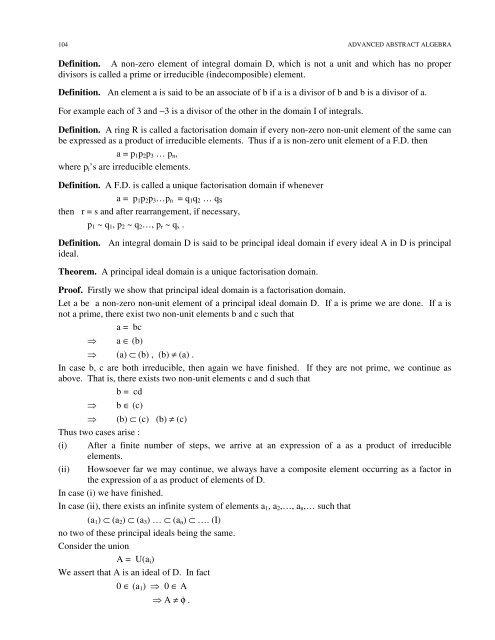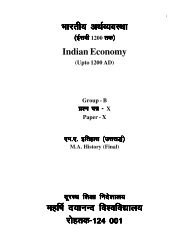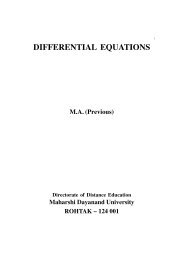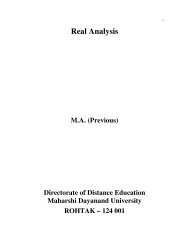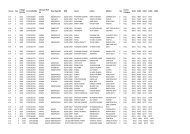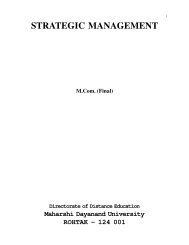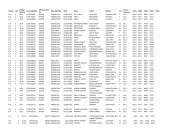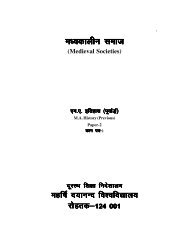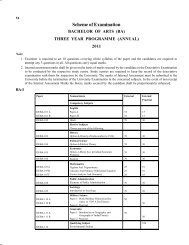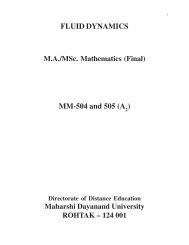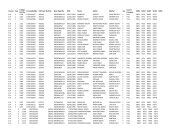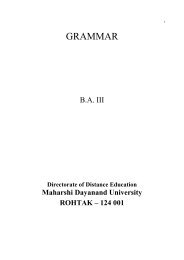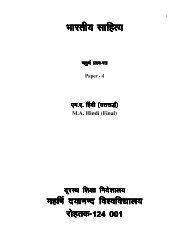Advanced Abstract Algebra - Maharshi Dayanand University, Rohtak
Advanced Abstract Algebra - Maharshi Dayanand University, Rohtak
Advanced Abstract Algebra - Maharshi Dayanand University, Rohtak
You also want an ePaper? Increase the reach of your titles
YUMPU automatically turns print PDFs into web optimized ePapers that Google loves.
104<br />
ADVANCED ABSTRACT ALGEBRA<br />
Definition. A non-zero element of integral domain D, which is not a unit and which has no proper<br />
divisors is called a prime or irreducible (indecomposible) element.<br />
Definition. An element a is said to be an associate of b if a is a divisor of b and b is a divisor of a.<br />
For example each of 3 and −3 is a divisor of the other in the domain I of integrals.<br />
Definition. A ring R is called a factorisation domain if every non-zero non-unit element of the same can<br />
be expressed as a product of irreducible elements. Thus if a is non-zero unit element of a F.D. then<br />
a = p 1 p 2 p 3 … p n ,<br />
where p i ’s are irreducible elements.<br />
Definition. A F.D. is called a unique factorisation domain if whenever<br />
a = p 1 p 2 p 3 …p n = q 1 q 2 … q S<br />
then r = s and after rearrangement, if necessary,<br />
p 1 ~ q 1 , p 2 ~ q 2 …, p r ~ q s .<br />
Definition. An integral domain D is said to be principal ideal domain if every ideal A in D is principal<br />
ideal.<br />
Theorem. A principal ideal domain is a unique factorisation domain.<br />
Proof. Firstly we show that principal ideal domain is a factorisation domain.<br />
Let a be a non-zero non-unit element of a principal ideal domain D. If a is prime we are done. If a is<br />
not a prime, there exist two non-unit elements b and c such that<br />
a = bc<br />
<br />
a ∈ (b)<br />
(a) ⊂ (b) , (b) ≠ (a) .<br />
In case b, c are both irreducible, then again we have finished. If they are not prime, we continue as<br />
above. That is, there exists two non-unit elements c and d such that<br />
b = cd<br />
<br />
b ∈ (c)<br />
(b) ⊂ (c) (b) ≠ (c)<br />
Thus two cases arise :<br />
(i) After a finite number of steps, we arrive at an expression of a as a product of irreducible<br />
elements.<br />
(ii) Howsoever far we may continue, we always have a composite element occurring as a factor in<br />
the expression of a as product of elements of D.<br />
In case (i) we have finished.<br />
In case (ii), there exists an infinite system of elements a 1 , a 2 ,…, a n ,… such that<br />
(a 1 ) ⊂ (a 2 ) ⊂ (a 3 ) … ⊂ (a n ) ⊂ …. (I)<br />
no two of these principal ideals being the same.<br />
Consider the union<br />
A = U(a i )<br />
We assert that A is an ideal of D. In fact<br />
0 ∈ (a 1 ) 0 ∈ A<br />
A ≠ φ .


